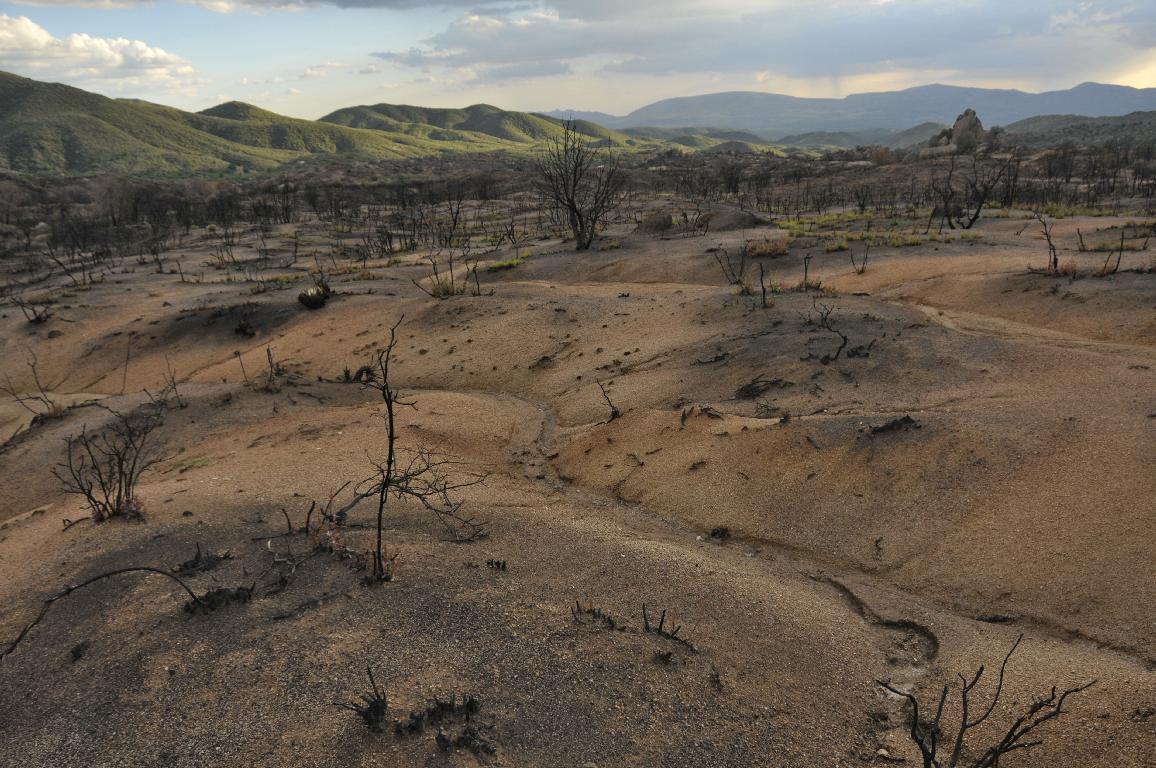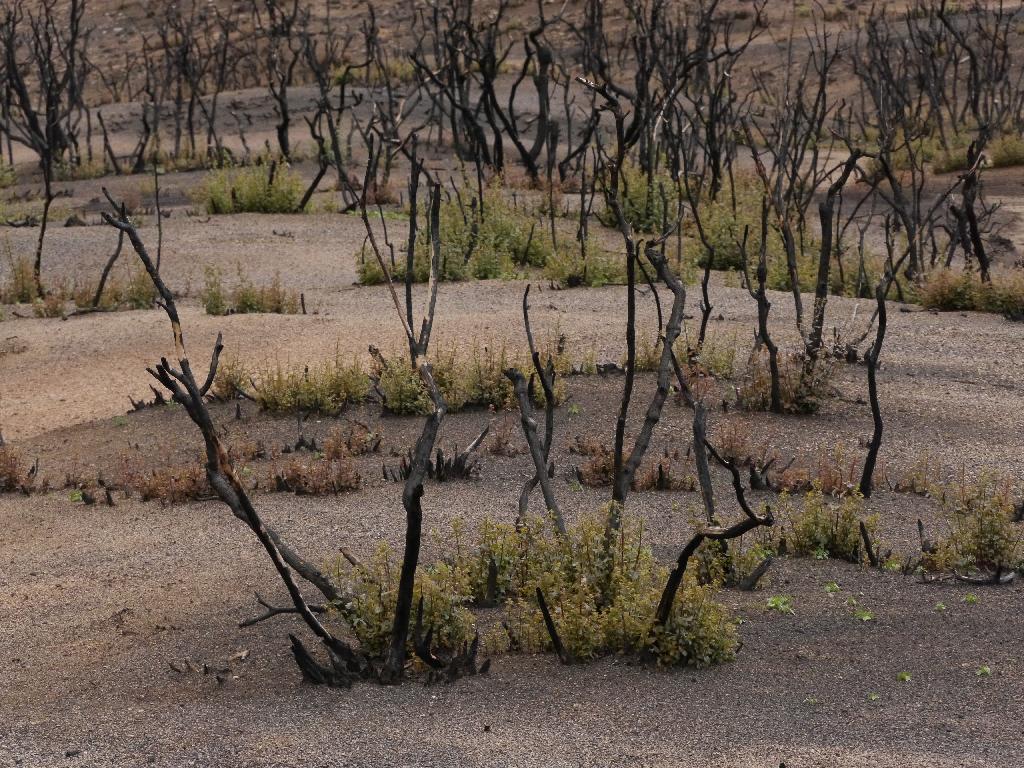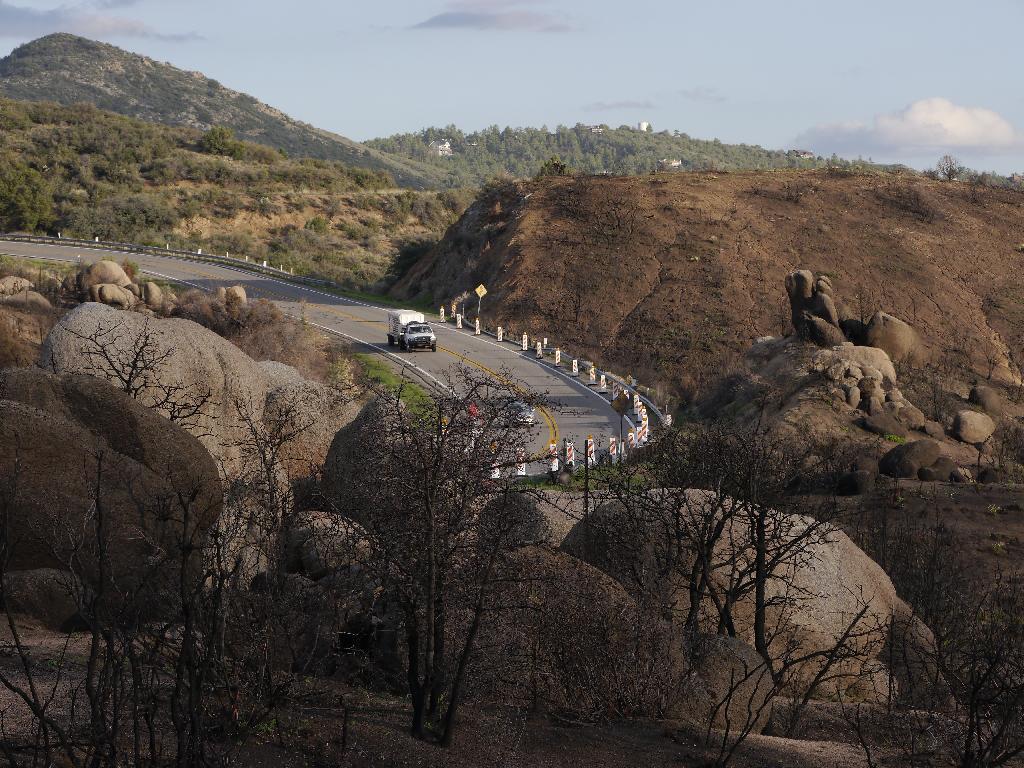29 June 2013. Prescott, Arizona. At Granite Mountain, eleven days after the eruption of the big Doce Fire, the smoke has cleared—mostly. There are still hot pockets (inedible ones) with potential for flames to rise from the ashes and run amok again. Mother Nature teases us with clouds trailing virga—and even a few drops of liquid that reach the ground—but the hot winds accompanying the clouds continue their mischief, and dry lightning ignites new blazes around the county. A microburst (sorry, not an artisan brew) takes down trees in town and starts a fire. The firefighters are still out there at the mountain, and aircraft drone overhead on their missions of attempted control. But for most of us, the adrenalin has subsided; our fears have receded.
30 June 2013. One of those fires started two days ago happened to be in Yarnell, and today it erupted into the disastrous fire that took the lives of 19 members of the Granite Mountain Hotshots, the same folks who fought the Doce Fire and, in the process, saved the sacred ancient juniper that may have watched the comings and goings of wildfire for millennia. I was photographing the aftermath of the Doce Fire when I saw the terrible black cloud rising to the south, so I raced down there and watched from a safe distance as the flames engaged in the chaotic dance of pyrotechnics triggered by an advancing monsoonal cell. I heard and saw the screaming influx of ambulances and feared for the worst—but it was even worse than my greatest fears.
Two major local disasters by fire in Yavapai County within two weeks. Sorrow and grieving for beloved Granite Mountain (clearly personified in the emotions of many) and the brave firefighters dominate discussion.
28 July 2013. Now a month later, our wounds healing with time, we can look at the context of these fires with a bit more rationality—or at least we should. “Don’t mess with Mother Nature” is a common phrase, and it exemplifies our tacit willingness to shift responsibility to a perceived natural deity rather than accepting an obligation to live our lives as informed citizens of Planet Earth.
Too often, our perception of the landscape—the forest, the chaparral, the grasslands—is a reflection of the myths we have all been exposed to. Bambi, Smoky the Bear, rain follows the plow, grazing prevents blazing, the only good wolf is a dead wolf, sustainable harvest, the decadence of old growth, nature’s balance, on and on. Illusions, fables, smoke and mirrors.
Not long after the Doce Fire, I went out Iron Springs Road to see the aftermath of the blaze in the chaparral. I had frequently heard the term “moonscape,” and at first, the analogy seems reasonable enough as you view how the once-dense thickets of oaks, junipers, manzanitas, and mountain mahogany have been reduced to charred skeletal remains emerging from a powdered mix of ash and dirt, exposed nakedly to wind and inevitable rain.
But “moonscape” goes too far. There are signs everywhere that life is knocked back but not vanquished. A cottontail hops away in a small island in the blackened landscape where a few shrubs and trees hold leaves somewhat desiccated but not burned. Two deer move gracefully among charred trunks. A raven glides overhead, perhaps searching for baked woodrat. Harvester ants scurry around their pyramids of tiny pebbles, colonies that survived because the ants had “cleared the perimeter” by removing all the fuels in a circle around the hole. Firewise landscaping?
The next question, of course, is what are the rabbit and the ant going to eat? There are no grasses left, no visible seeds on the ground. There is little cover from hungry predators. The death toll from the fire may rise over time, but this may be compensated for in part by increased fecundity of the survivors. There is tremendous resilience in this ecosystem. Forget about moonscape!
To an observant eye, the simplified scene shows that this land has felt the hot kiss of fire before. Stubs arise in clusters from the ground—scrub oaks burned off in the past that sprouted from their underground nutrient warehouses, lignotubers. Their cellular machinery is ready to do so again. Already, emerging sprouts lift brave stems and leaves to start over. A scrub oak five feet high may look young, but check out that lignotuber: it might be as old as that ancient juniper that was skipped by the fire.
Similarly, the above-ground stems of mountain mahogany are goners, but root- and rhizome-sprouting is likely in most areas. In fact, root symbionts (actinomycetes called Frankia) crank up their activity after typical fire and start replacing the volatile nitrogen that escaped with the flames. So mountain mahogany is also a sprouter, and its nitrogen-fixing properties will improve soil conditions for many organisms.
See that elegantly shaped skeleton of a manzanita? Dead, yes, but all around are its seeds, hidden in the soil until awakened from sleep by the warmth of the fire or the caress of chemicals leached from the ash. Maybe the sprouters will have a head start, but the re-seeders have their own evolutionary strategies to make a dramatic comeback. In the long run, both types thrive in systems with fire, and the balance of each reflects both chance placement and the fire frequency.
The old chaparral stand that stood here two weeks ago was a nightmare to try to get through. Interlocking branches, spiny or scratchy leaves—these will test the stiffest Carharts of anyone trying to force a way through (the “chaps” worn by a horseman were designed to protect the legs of anyone riding through these thickets). Now with the thickets gone, the little plants will have a chance. Annuals and perennials whose seeds have lain dormant in the shaded soils now can germinate. Grasses, penstemons, verbenas, buckwheats, four o’clocks, and the short-lived shrubs of yerba santa will have their day in the sun before the sprouting and reseeding shrubs again take over.
There will be a related succession of animals. Those in intact chaparral on the edges of the burn will use that cover for nesting or denning but will venture out for food as succession gets rolling. As sufficient cover develops, many will reoccupy the recovering burn. Relative abundances will shift as the small annuals and perennials are overtopped by the ascending shrubs. The seeders will eventually catch up with the sprouters, and there will be a rich mosaic of dense shrubs locked in slow competition for light and nutrients. As they say, nothing succeeds like succession. In a few decades, there will be the appearance of old-growth chaparral, and given that the sprouters have done this over and over again, some of those shrubs could be centuries old.
I look up at the high ridge to the west, a ridge that has a sensational view of both Skull Valley to the southwest and the Prescott Basin to the east, with Granite Mountain looming to the north. Million-dollar views, for sure, and there are houses perched up there to take advantage. What a view those folks must have had when the fire was racing north just to the west and northwest of them.
It should have been a sobering view. Perhaps the shocking fate of many homes in the chaparral in Yarnell should serve as a wake-up call, for chaparral creates a fuel load with the potential for a conflagration that no air tanker, no team of hotshots, could counteract. Those houses were lucky—this time—but they are sitting on a powder keg. Ask some of the ridgetop residents of Oakland, California, or San Diego, what wildfire in chaparral can do.
Chaparral fire is fast and furious. One minute, you cannot walk through the dense tangles; a few minutes of fire later, you could hot-foot it through there without touching a stem. Extreme oxidation followed by extreme reduction in life.
More and more homes are being built in the urban-wildlands interface, whether that be on a barrier island exposed to hurricanes, a floodplain low on a large watershed, the slopes of a temporarily sleeping volcano, a forest of dense pines, or a ridgeline in chaparral. The realtors praise the location to unwary buyers—imagine being able to walk out your back door and into the national forest! Wildlife in your yard! Natural landscaping such that you don’t even have to mow the lawn!
Smoke and mirrors.
Where is that realtor when your house is gone, when your possessions are melted into unrecognizable forms and your landscaping is now nothing but ash? To whom do you direct your anger and anguish? Is it the fault of the Forest Service for allowing its forest to be wild? Well, maybe past fire suppression and other practices set the stage for the severity of this fire, but then, how could the managers do prescribed burns with resources few and with houses standing in the way of an easily controlled burn? When resources are focused mainly on extinguishing fires to save houses, they are not available for thinning forests or reducing chaparral (a losing battle anyway, since chaparral grows back so quickly). We are treating symptoms with our battles against fires, not causes.
The federal government just shifted the balance of financial support toward more fire fighting and away from proactive habitat management. Predictions say there will be more frequent, larger, more severe fires ahead, and recent history backs up those claims. The Granite Mountain Hotshots were brave men doing a difficult job. We honor their memory and their dedication. But were their sacrificed lives worth the saving of houses built in sites of high vulnerability to fire? Could we be setting ourselves up for even costlier consequences in the future?
Part of the problem is simple hubris—we act as if we can control the world if we use our technology to its fullest extent. Well, how is that going? I call it landscape lunacy, and I attribute it to a general lack of ecological literacy. Somehow we need to restore not just stronger connections to nature but also an in-depth understanding of how nature works. With such understanding, we would discourage building in that volatile urban-wildland interface, and we would expect anyone who did so to face the consequences, should an event like wildfire occur. We need to take personal responsibility for our actions. If we step in front of a speeding truck, we cannot expect anyone to save us; Superman, by the way, is a myth. Similarly, if we build on a ridgetop above a sea of chaparral, we may have built our own pyre.
A naturalist has the gift (or curse) of being able to see through time. He or she knows that the snapshot of the forest or scrubland is no more than that; the landscape is dynamic, subject to sudden and sometimes even irreversible change. That wonderful monsoon rain that brings a profusion of fresh growth is actually setting the stage for a potential major burn should that lush vegetation dry out and then ignite for any reason. That steep brushy slope holds the potential for damaging landslides should cover be removed or soils oversaturated. That lovely, dense stand of pines that we admire as the backdrop for town is actually sucking up moisture that otherwise might be coming down our creeks and supporting fish, frogs, and herons.
If we lack ecological literacy, the landscape can be a mirage, sickness disguised as scenery. Unless we return to our natural history roots (a radical idea in the original sense), we cannot make sensible (truly using our senses) diagnoses and treatments.






Thanks for the thoughtful words, Walt. Maybe a few will think about ego-driven, poor choices and move toward a more sustainable life style.
And, it seems, there will be more chaparral and scrub environment as our ponderosa are affected by global climate change, drought, and extreme fire.
Your essays are appreciated.
Blessings,
Doug
Thanks, Doug. You are certainly right that we may witness some dramatic type changes in our forest and throughout the West. We need to change our basic expectations and grow up a bit in terms of accepting personal responsibility for our actions.
This essay was picked up on New Clear Vision and retitled “Landscape Lunacy: Reflections on Hubris, Mythology, and Ecological Literacy.” http://www.newclearvision.com/2013/08/16/landscape-lunacy/
Walt — Thank you for a well-written article. I am in full agreement with your sentiments and I loved the way you word-smith your thoughts and poke at the ludicrous attitudes of ‘the powers that be.’ Our Natural History Roots have suffered the diseases of short-term reward and blind acceptance, and, as a wildlife biologist (currently working for the education department of the Chaffee Zoo in Fresno, CA), I try to turn at least one young brain a day back towards that lost path. I was gathering information on fire-based communities and stumbled onto your blog. I shall be visiting your site again. Thank you again, sincerely … Fresno’s Bat Lady